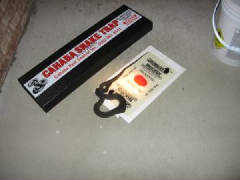FREQUENTLY ASKED QUESTIONS
How are snakes
attracted to Cahaba Snake Trap?
First you must place the trap
in the correct location. In the wild, snakes seek cover for their protection and a place to hide.
Cahaba Snake Trap give the appearance of both a place to hide and protection. The snake crawles in for his safety and
a place to wait for food and is caught in the glue insert.
Why is Cahaba Snake Trap better than other similar
products?
Cahaba snake trap is made of a higly ridged plastic which
makes it very strong.
The plastic makes the trap water resistant and
can be use in wet or damp places.
The trap can be used when
sprinklers are in use. The trap is made to be free standing. It is re-usable and can be used again and again, all you
need to do is replace the glue inserts and if needed, you can order more inserts. The trap is consumer friendly and safe
for children and pets. Cahaba Snake Trap is higly economical because it is re-usable. (best trap on
the market)
How can I tell the difference between poisonous and non-poisonous snakes?
There are only 4 species of poisonous snakes in North America; Copperhead, Rattlesnake,
Water Moccasin and Coral Snake. Learn to identify these snakes from photos and you can safely assume all other snakes you
see in North America are non-poisonous.
What are Pit Vipers?
Pit
Vipers have a small heat sensor or pit on each side of the head between the eye and nostril. This pit is used to locate
warm-blooded prey. It acts like an infrared heat detector. However, the pit doesn't accurately tell the size of
the prey. Unfortunately, snakes don't see well at night and as a result you could be mistaken for prey at night.
Three of four North American poisonous snakes species are pit vipers; Cottonmouth, Rattlesnake and Copperhead.
What should I do if I'm bitten by a poisonous snake?
Most
methods of self treatment are now deemed to cause more harm than good. The best thing to do is remain calm and seek
professional medical care as soon as possible.
How dangerous are bites from a poisonous snake?
Small children are in more danger than adults because the venom is more concentrated
in their smaller body mass. It also depends on how much venom is received. Everyone who is injected with venom
should receive medical treatment. It is estimated that 10-15 people die each year from snake bites in North America.
If I'm bitten by a poisonous snake, should I kill it and take it to the hospital for identification?
No, once you get to the hospital a simple blood test can determine what kind of
venom is in your system. Emergency room staffs rightfully take a dim view of bringing snakes (alive or dead) into the
emergency room.
Do rattlesnakes always rattle to warn us?
They
usually do, but not always. They rattle because they are frightened and they think they will be seen. If they
are secure in their camouflage, they probably won't rattle.
Can snakes hear?
No, regardless of what you may have heard about making noise to warn snakes of approach or presence, they
are completely deaf and live in a silent world. However, they can pick-up small, minute ground vibrations of other creatures
(including us) moving in their immediate area. It's one way they avoid danger and enemies. They also use this
ability to locate prey.
Are snakes really afraid of us?
Yes.
They live in a world of eat or be eaten. They take one look at us and "think","I can't eat this thing,
but it's big enough to eat me". Consequently, they are very much afraid of us.
Why does a
snake flick out its tongue?
A snake's scent glands are located in its
tongue. When it flicks out its' tongue, it is "smelling" the air, usually because it is concerned about another
creature moving in its immediate vicinity.
Will non-poisonous snakes bite?
Yes, they will bite if they are threatened or cornered. Though their bit is not normally considered
life theatening, they can be extremely painful and cause bleeding, infection and scarring.
Can the age
of a rattlesnake be determined by the number of its' rattlers?
Not
really, a new rattler is added each time a rattlesnake sheds its' skin, which could be anywhere from 2 to 4 times per year.
Do snakes lay eggs or bear their young alive?
Some snakes
lay eggs, others bare their young alive. there is no such thing as a "mother" snake. After eggs are
deposited or the baby snakes are born, the female's responsibility ends.
Can snakes bite while they are underwater?
Yes, they can open their mouths and bite while under water.
What do snakes
eat?
Snakes eat worms, insects, lizards, small mammals, birds, eggs,
frogs, fish and other snakes.
THIS SNAKE WAS TRYING TO GET IN A DRYER VENT ON A PATIO
